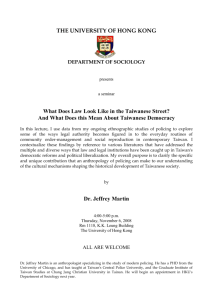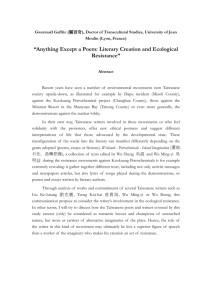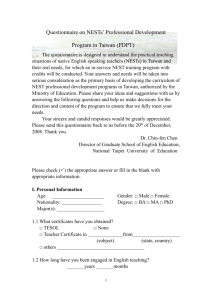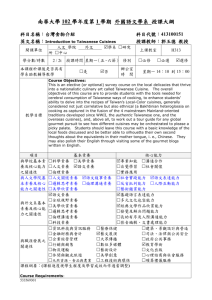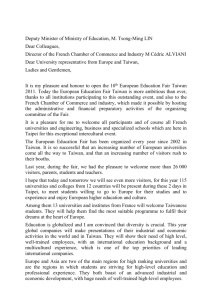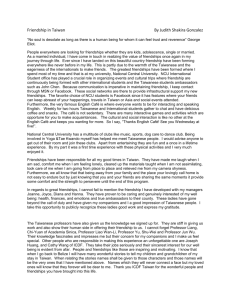A Cross-Cultural Comparison of Life Style Between Taiwanese and
advertisement
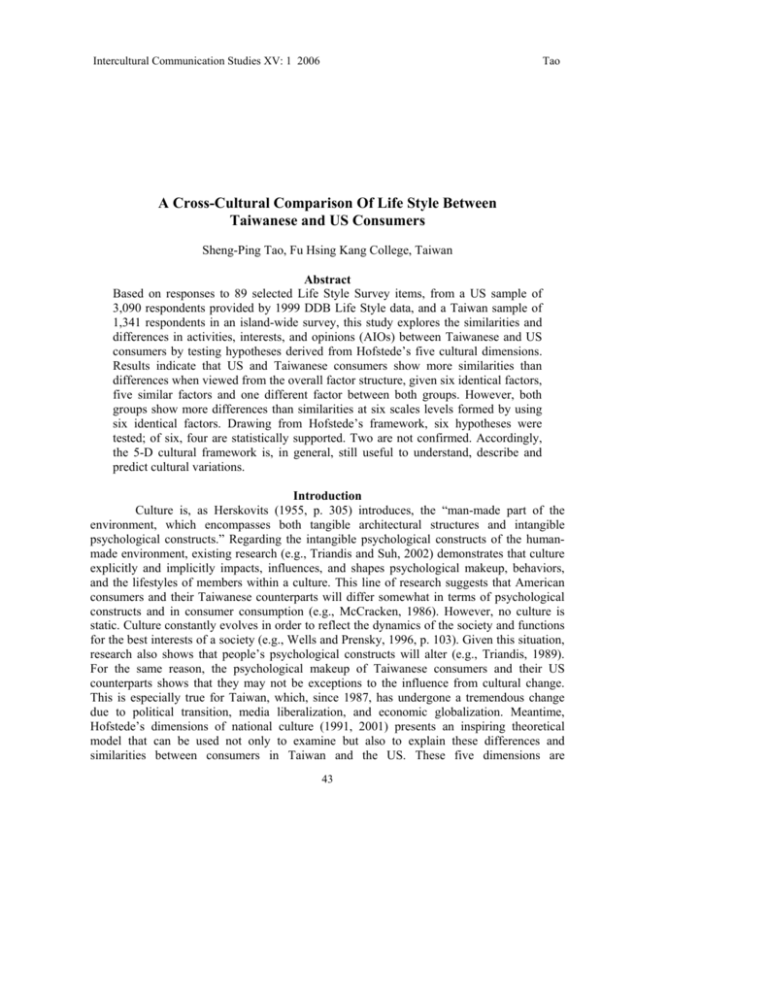
Intercultural Communication Studies XV: 1 2006 Tao A Cross-Cultural Comparison Of Life Style Between Taiwanese and US Consumers Sheng-Ping Tao, Fu Hsing Kang College, Taiwan Abstract Based on responses to 89 selected Life Style Survey items, from a US sample of 3,090 respondents provided by 1999 DDB Life Style data, and a Taiwan sample of 1,341 respondents in an island-wide survey, this study explores the similarities and differences in activities, interests, and opinions (AIOs) between Taiwanese and US consumers by testing hypotheses derived from Hofstede’s five cultural dimensions. Results indicate that US and Taiwanese consumers show more similarities than differences when viewed from the overall factor structure, given six identical factors, five similar factors and one different factor between both groups. However, both groups show more differences than similarities at six scales levels formed by using six identical factors. Drawing from Hofstede’s framework, six hypotheses were tested; of six, four are statistically supported. Two are not confirmed. Accordingly, the 5-D cultural framework is, in general, still useful to understand, describe and predict cultural variations. Introduction Culture is, as Herskovits (1955, p. 305) introduces, the “man-made part of the environment, which encompasses both tangible architectural structures and intangible psychological constructs.” Regarding the intangible psychological constructs of the humanmade environment, existing research (e.g., Triandis and Suh, 2002) demonstrates that culture explicitly and implicitly impacts, influences, and shapes psychological makeup, behaviors, and the lifestyles of members within a culture. This line of research suggests that American consumers and their Taiwanese counterparts will differ somewhat in terms of psychological constructs and in consumer consumption (e.g., McCracken, 1986). However, no culture is static. Culture constantly evolves in order to reflect the dynamics of the society and functions for the best interests of a society (e.g., Wells and Prensky, 1996, p. 103). Given this situation, research also shows that people’s psychological constructs will alter (e.g., Triandis, 1989). For the same reason, the psychological makeup of Taiwanese consumers and their US counterparts shows that they may not be exceptions to the influence from cultural change. This is especially true for Taiwan, which, since 1987, has undergone a tremendous change due to political transition, media liberalization, and economic globalization. Meantime, Hofstede’s dimensions of national culture (1991, 2001) presents an inspiring theoretical model that can be used not only to examine but also to explain these differences and similarities between consumers in Taiwan and the US. These five dimensions are 43 Intercultural Communication Studies XV: 1 2006 Tao individualism/collectivism, power distance, uncertainty avoidance, masculinity/femininity, and long-term orientation. Motivated by such a compelling conceptual framework and benefiting from a national-level US sampled database of activities, interests, and opinions (AIOs) from the DDB Life Style Study, this study has two purposes. The first purpose is to explore, in a cross-cultural setting, the similarities and differences in AIOs between Taiwanese and US consumers. An understanding obtained from the first purpose will be useful for global marketers in devising appropriate marketing strategies to target American and Taiwanese consumers who live in quite different culturalsocietal contexts. The second purpose attempts to examine the similarities or differences between the two groups of consumers by testing hypotheses derived from Hofstede’s theoretical framework of five cultural dimensions. The second purpose will provide insight into what extent Hofstede’s dimensions of national culture, which are derived from personnel in a large multinational company in the late 1960s and early 1970s to measure management and organization practices, are applicable to consumers regarding their AIOs at the turn of the 21st century. Although results from Hofstede’s framework were validated against about 40 other cross-cultural studies from various disciplines (De Mooij, 1998, p. 72), there is no empirical data to investigate the validity in a comparative AIO setting between current Taiwanese and American consumers. Method Samples Description of Administration of DDB Sample. This study compares US consumer responses collected in the 1999 Life Style survey to those of Taiwanese counterparts collected in a procedure that echoes the census data. According to Piirto (1991, p. 110), the DDB Life Style survey is the second longest continuously running psychographics study and the most highly detailed consumer lifestyle database currently available. In order to make sure that the sample would match the population, the DDB 1999 sample was compared with the 2000 US census mainly on gender, age, income and area of residence. Results show that percentages of females and people aged over 55 in DDB 1999 were much higher than the census (female: DDB, 54.9% vs. census, 50.9%; aged 55 over: DDB, 33.3% vs. census, 21%). As such, a certain number of respondents were randomly deleted and then compared to the sample with the population regarding these four demographics. If the two did not match, respondents continued to be randomly deleted until the samples and population generally matched each other. At the end, 298 respondents were dropped, leaving 3,090 in the sample. Description of Administration of Taiwan Sample. Because the Life Style survey is not conducted in Taiwan, a sampling method was designed to choose a sample that would include respondents from the widest general population possible. The goal was a large sample of adult consumers in Taiwan, which might be comparable to DDB’s counterparts of adult consumers in the United States. Serving in the Taiwan Navy for 15 years, I took advantage of this convenience to overcome the shortage of monetary resources. Otherwise, it would have been difficult for this kind of national population sample to be conducted. According to the Constitution of the Republic of China (Taiwan), it is mandatory for a man to serve in the armed forces for two years when he reaches 18 years (except for the disabled and exceptional cases). Many of these young men, by drawing lots, are assigned into four major branches of the armed forces (Army, Navy, Air force, Marines) and are then assigned to different units in 44 Intercultural Communication Studies XV: 1 2006 Tao the same way. In general, a unit consists of young men with diverse social economic status as well as having diversity in personal backgrounds and coming from different cities and counties of Taiwan. With the support of the Taiwan Navy personnel as survey agents, the Navy Address Codebook was used as the sampling frame and six units were randomly selected. These six units, including the missile-guiding destroyer, the minesweeper, and the landing craft, contained around 900 sailors and officers. Under the assistance of captains and commanding officers, officers and sailors were recruited to ask their families, relatives, friends and neighbors, who were over the age of 18, to complete a shortened Chinese version of DDB Life Style survey. In addition, two rounds of supplementary surveys were conducted by taking the round-island train rider during weekends and weekdays to interview passengers and commuters to increase the proportion of females in the research. In the Navy, very few females serve in the fleet. Except for one county, the round-island train trips allowed me to survey potential respondents who might come from different parts of Taiwan. In order to increase the return rate, an incentive gift certificate was used to encourage participant cooperation. In addition, a sweepstakes was announced, in which three participants were drawn from each unit to receive another substantially larger gift certificate. In the Navy survey, these efforts brought about 1,527 effective samples from a total of 1,800 questionnaires, with a response rate at 84.8%. Just as the US sample was modified to echo the general population, the same deletion process was applied to make the Taiwan sample match population to the 2000 Taiwan census on gender, age, income and area of residence. In the end, 186 respondents were dropped leaving 1,341 in the sample. Instrument (Questionnaire) Description of the Instrument. The DDB Life Style survey is designed to survey American consumer behaviors. Some of the items used are not relevant to the Taiwan case. In order to compare the two samples, the Taiwanese questionnaire is based on the DDB version as closely as possible. As such, five items were eliminated from 230 original items on the part of AIO in the 1999 DDB Life Style Study. For instance, items in conflict with current laws in Taiwan, such as “there should be a gun in every home,” and “the use of marijuana should be legalized” were excluded. A total of 225 items are left for further analysis. After a principal components analysis, with Varimax rotation at 0.40 item-loading criteria, 42 factors were generated with Eigenvalue greater than one. Of them, 13 factors were deleted due to the small number of items less than three, which is questionable for scale construction. Also, items that loaded on two factors were also dropped. Afterwards, Cronbach’s coefficient alpha was applied to check the reliability of each factor. Any factor with an Alpha value below 0.60 was removed. Thus, the final number of factors with satisfactory reliability was 17, consisting of 89 items, which explained 36.28% of the total variance. Combining these categories with some demographic items, the questionnaire has 100 items. After back translation, it was used to survey Taiwanese respondents. A Tale Of Two Countries On Consumer Constructs An exploratory factor analysis with Varimax was applied to the US sample and the Taiwan sample respectively. Eighteen factors were generated for the US sample and 19 for the Taiwan sample with Eigenvalues greater than one. Although the number of factors is 45 Intercultural Communication Studies XV: 1 2006 Tao similar in both samples, the factors differ in item-clustering and item-loading values. They also differ in the factor order of the structure. Dimensions of American Consumer Behaviors There are 18 factors accounting for 55.85% of the total variance of the US respondent’s factor structure. The structure of factor analysis presents a general profile of American consumers. Factors with the Alpha value and items with the loading value in every factor are listed as follows. Factor 1: Health Consciousness, α = .89, includes that I try to avoid foods that are high in fat (.81); I try to avoid foods that are high in cholesterol (.77); I am concerned about how much sugar I eat (.71); I use a lot of low calorie or calorie reduced products (.71); Nutritional information on food labels determines which products and brands I buy (.67); I make a special effort to get enough fiber (bran) in my diet(.66); I try to avoid foods with a high salt content (.66); I am careful about what I eat in order to keep my weight under control (.63); I try to select foods that are fortified with vitamins and minerals (.61); I like to avoid foods that have additives in them (.54); I am concerned about getting enough calcium in my diet (.51). Factor 2: Financial Anxiety, α = .86, includes that No matter how fast our income goes up we never seem to get ahead (.75); Saving for the future is a luxury I can’t afford right now (74); Our family is too heavily in debt today (73); Credit cards have gotten me into too much debt (.67); I am not very good at saving money (66); There’s no way I’ll be able to put away enough money to retire (.65); Our family income is high enough to satisfy nearly all our important desires (.65); Banks make it difficult for me, personally, to borrow money (.60); I pretty much spend for today and let tomorrow bring what it will (.51). Factor 3: Fulfillment Through Appearances, α = .80, embraces that It is important to me to wear clothes in the latest style (.77); I have more stylish clothes than most of my friends (.70); Dressing well is an important part of my life (.68); It is important for me to have my hair cut in the latest style (.65); I prefer to buy products with designer names (.54); I enjoy getting dressed up (.50). Factor 4: Fulfillment Through Kitchen Behavior, α = .81, embraces that I like to cook (.87); I like to bake (.79); I am a sophisticated cook (.72); The kitchen is my favorite room (.65); I am interested in spices and seasonings (.62). Factor 5: Libertarian Values, α = .77, embraces that I am in favor of legalizing doctor-assisted suicide (.75); I am in favor of legalized abortions (.71); Public high schools should be allowed to distribute condoms to students (.64); I am in favor of legalizing same sex marriages (.62); Couples should live together before getting married (.55). Factor 6: Traditional Gender Values, α = .77, contains that Men are naturally better leaders than women (.82); Men are smarter than women (.78); The father should be the boss in the house (.68); Men are better at investing money than women (.65); A woman’s place is in the home (.58). Factor 7: Life Dissatisfaction, α = .77, contains that I feel like I’m so busy trying to make everybody else happy that I don’t have control of my own life (.67); I feel I am under a great deal of pressure most of the time (.62); I wish I knew how to relax (.60); Some things I feel that I don’t have enough control over the direction my life is taking (.59); My home life is chaotic (.58). Factor 8: Environmentalist Values, α = .74, contains that I support pollution standards even if it means shutting down some factories (.69); I worry a lot about the effects 46 Intercultural Communication Studies XV: 1 2006 Tao of environmental pollution on my family’s health (.61); I make a special effort to buy from companies that support charitable causes (.60); I try to buy products that use recycled packaging (.59); I would be willing to accept a lower standard of living to conserve energy (.53); I make a strong effort to recycle everything I possibly can (.41); I make a special effort to look for products that are energy efficient (.41). Factor 9: Spiritual Fulfillment, α = .79, holds that I believe in God (.76); Religion is an important part of my life (.74); It’s important to me to find spiritual fulfillment (.74); I believe in the existence of the Devil (.67). Factor 10: Boycott Orientation, α = .69, holds that I avoid buying products advertised on violent TV programs (.68); I avoid buying products advertised on shows with too much sexual content (.67); TV commercials place too much emphasis on sex (.57); I refuse to buy a brand whose advertising I dislike (.55); Advertising insults my intelligence (.53). Factor 11: Self Satisfaction, α = .72, includes that I am in very good physical condition (.73); I have more energy than most people my age (.71); When I look in the mirror I like what I see (.69); I think I’m very good looking (.56). Factor 12: Brand Orientation, α = .65, includes that I try to stick to well-known brand names (.75); Given the choice, I would buy a brand name prescription drug rather than a generic prescription drug (.68); A nationally advertised brand is usually a better buy than a generic brand (.66); When I have a favorite brand I buy it – no matter what else is on sale (.63). Factor 13: Opinion Leadership, α = .60, embraces that I am influential in my neighborhood (.71); My friends and neighbors often come to me for advice about products and brands (.65); I like to be considered a leader (.59); We have more to spend on extras than most of our neighbors do (.47). Factor 14: Extroversion Orientation, α = .64, embraces that I would rather spend a quiet evening at home than go out to a party (.79); I am a homebody (.75); I enjoy parties, games, shows – anything for fun (.52). Factor 15: Health Situation, α = .56, contains that I get more headaches than most people (.61); I frequently get indigestion (.61); If I don’t feel well, I take a pain reliever or other medication right away (.59); I have trouble getting to sleep (.54). Factor 16: Innovator Bent, α = .60, contains that Information from advertising helps me make better buying decisions (.69); I like to buy new and different things (.58); I am usually among the first to try new products (.44). Factor 17: New Hope, r = .43, holds that If I had my life to live over, I would sure do things differently (.61); I wish I could leave my present life and do something entirely different (.60). Factor 18: Impulsive Buyer, holds only one item that is I am an impulse buyer (64). Dimensions of Taiwanese Consumer Behaviors The structure of Taiwanese consumers consisted of 19 factors accounting for 57.56% of the total variance. The profile of Taiwanese consumers creates a similar impression. Factor 1: Health Consciousness, α = .87, includes that I try to avoid foods that are high in cholesterol (.76); I try to avoid foods that are high in fat (.75); I try to avoid foods with a high salt content (.73); I am careful about what I eat in order to keep my weight under control (.67); I like to avoid foods that have additives in them (.65); I use a lot of low calorie or calorie reduced 47 Intercultural Communication Studies XV: 1 2006 Tao products (.65); I make a special effort to get enough fiber (bran) in my diet (.64); I am concerned about how much sugar I eat (.64); I try to select foods that are fortified with vitamins and minerals (.60); Nutritional information on food labels determines which products and brands I buy (.54). Factor 2: Financial Anxiety, α = .79, includes that Saving for the future is a luxury I can’t afford right now (.74); There’s no way I’ll be able to put away enough money to retire (.70); No matter how fast our income goes up we never seem to get ahead (.69); Our family is too heavily in debt today (.64); I am not very good at saving money (.61); Banks make it difficult for me, personally, to borrow money (.43). Factor 3: Fulfillment Through Kitchen Behavior, α = .85, embraces that I like to cook (.85); The kitchen is my favorite room (.84); I am a sophisticated cook (.82); I like to bake (.71); I am interested in spices and seasonings (.62). Factor 4: Traditional Gender Values, α = .81, contains that Men are smarter than women (.80); Men are naturally better leaders than women (.80); The father should be the boss in the house (.74); A woman’s place is in the home (.71); Men are better at investing money than women (.70). Factor 5: Vogue, α = .85, embraces that It is important to me to wear clothes in the latest style (.82); It is important for me to have my hair cut in the latest style (.80); I have more stylish clothes than most of my friends (.80); When I look in the mirror I like what I see (.42). Factor 6: Impulsive Buyer, α = .82, embraces that I like to buy new and different things (.76); I am an impulse buyer (.71); I am usually among the first to try new products (.70); I pretty much spend for today and let tomorrow bring what it will (.55); I frequently buy things when I can’t afford them (.48). Factor 7: Environmentalist Values, α = .74, contains that I try to buy products that use recycled packaging (.78); I make a strong effort to recycle everything I possibly can (.74); I worry a lot about the effects of environmental pollution on my family’s health (.66); I Make a special effort to look for products that are energy efficient (.66). Factor 8: Libertarian Values, α = .74, embraces that Couples should live together before getting married (.74); I am in favor of legalizing same sex marriages (.70); Public high schools should be allowed to distribute condoms to students (.68); I am in favor of legalized abortions (.66); I am in favor of legalizing doctor-assisted suicide (.60). Factor 9: Spiritual Fulfillment, α = .82, holds that I believe in God (.88); I believe in the existence of the Devil (.81); Religion is an important part of my life (.71); It’s important to me to find spiritual fulfillment (.70). Factor 10: Life Dissatisfaction, α = .73, includes that I feel I am under a great deal of pressure most of the time (.68); If I had my life to live over, I would sure do things differently (.68); I feel like I’m so busy trying to make everybody else happy that I don’t have control of my own life (.60); I wish I knew how to relax (.58); I wish I could leave my present life and do something entirely different (.58); Some things I feel that I don’t have enough control over the direction my life is taking (.56). Factor 11: Brand Orientation, α = .73, includes that I try to stick to well-known brand names (.68); A nationally advertised brand is usually a better buy than a generic brand (.66); When I have a favorite brand I buy it – no matter what else is on sale (.63); I prefer to buy products with designer names (.57). 48 Intercultural Communication Studies XV: 1 2006 Tao Factor 12: Dressing-up Orientation, α = .70, includes that Dressing well is an important part of my life (.77); I enjoy getting dressed up (.75); I think I’m very good looking (.60). Factor 13: Health Situation, α = .73, contains that I frequently get indigestion (.78); I have trouble getting to sleep (.77); I get more headaches than most people (.71). Factor 14: Boycott Orientation, α = .65, holds that I avoid buying products advertised on violent TV programs (72); I avoid buying products advertised on shows with too much sexual content (.68); TV commercials place too much emphasis on sex (.63); I refuse to buy a brand whose advertising I dislike (.56); Advertising insults my intelligence (.55). Factor 15: Extroversion Orientation, α = .65, embraces that I would rather spend a quiet evening at home than go out to a party (.86); I am a homebody (.84); I enjoy parties, games, shows – anything for fun (.49). Factor 16: Self Satisfaction, r = .60, includes that I have more energy than most people my age (.71); I am in very good physical condition (.73). Factor 17: Financial Optimism, r = .51, embraces that Our family income is high enough to satisfy nearly all our important desires (.78); We have more to spend on extras than most of our neighbors do (.78). Factor 18: Energy Conserving holds only one item that is I would be willing to accept a lower standard of living to conserve energy (.76). Factor 19: Helpfulness of Advertising also holds one item that is Information from advertising helps me make better buying decisions (.72). When comparing the factor structures between two groups, there emerge similarities and differences between Americans and Taiwanese regarding these consumer behavior dimensions. Three categories were created: “identical,” “similar,” and “different.” The identical category refers to items that load in the same factor, and emerge in both samples. The “similar” category includes factors that share more than half of the items between American and Taiwanese consumers. The “different” category refers to factors that appear in one sample, but do not appear in the other. Any factor with less than three items and an Alpha value below 0.60 was excluded at this factor-level comparison. Table 1 shows the results. Table 1: Comparison between US and Taiwan Consumers on Factor Structures Alpha Number of items loaded Shared Items US TW US TW Identical Libertarian Values .77 .74 5 5 5 Fulfillment through Kitchen .81 .85 5 5 5 Behavior Traditional Gender Values .77 .81 5 5 5 Spiritual Fulfillment .79 .82 4 4 4 Boycott Orientation .69 .65 5 5 5 Extroversion Orientation .64 .65 3 3 3 Similar Health Conscious .89 .87 11 10 10 Financial Anxiety .86 .79 9 6 6 49 Intercultural Communication Studies XV: 1 2006 Tao Environmentalist Values .74 .80 7 4 4 Brand Orientation .65 .73 4 4 3 Life Dissatisfaction .77 .73 5 6 4 Different Opinion Leadership .60 4 As can be seen, six factors have identical items across both samples. They are factors of “fulfillment through kitchen behavior,” “libertarian values,” “traditional gender values,” “spiritual fulfillment,” “boycott orientation,” and “extroversion orientation.” Five factors of “health conscious,” “financial anxiety,” “environmentalist values,” “brand orientation,” and “life dissatisfaction” belong to the category of similar dimensions. With regard to the different category, there is one factor that emerged in the American sample, but is not found in the Taiwanese sample. The “opinion leadership” with three of four items did not appear in the Taiwan sample. The three items are: “I am influential in my neighborhood,” “my friends and neighbors often come to me for advice about products and brands,” and “I like to be considered a leader.” Factors with a different factor name in the Taiwan consumer structure such as “vogue,” “dressing-up orientation” and in the US consumer structure such as “fulfillment through appearances,” “innovator bent,” are not grouped into different categories. Items are still found in both sample structures although those items are not loaded in the same factor between the overall structures of the US and Taiwanese consumer. For example, there are three items in factor 16 of the US consumer structure. Of three, two items: “I like to buy new and different things,” and “I am usually among the first to try new products” are loaded in factor 6 of the Taiwan sample and one item: “information from advertising helps me make better buying decisions” was loaded in factor 19 of the Taiwan sample. This case is very different from the case of “opinion leadership,” given that items in the US consumer structure were missing in the Taiwan consumer structure. According to Table 1, there are more similarities than differences between American consumers and their Taiwanese counterparts in terms of factor structure. Six factors are identical and five factors are similar. In particular, the six identical factors can, at least in this study, cross national borders. Although the US and Taiwan differ in cultural societal settings, the same six dimensions show up in both samples. This empirical finding from Table 1 generally supports Schutte and Ciarlante’s (1998, p. 92) argument that they agree that Abraham Maslow’s (e.g., 1968) bottom two levels of hierarchy of needs (physiological needs and safety needs) are universal, but the top two levels of hierarchy of needs (self-actualization needs and ego needs) will be culturally bound. Based on Confucianism, Schutte and Ciarlante (1998, p. 90) deductively reason that ego needs and self-actualization will be absent from the Asian cultural context or subordinated to social need in Asia. Among the six identical and five similar factors, the factors of “fulfillment through kitchen behavior” and “health consciousness” relate to Maslow’s physiological needs. Food and health are two basic needs for human survival. The factors of “spiritual fulfillment,” “libertarian values,” “financial anxiety,” and “environmentalist values” belong to safety needs. Religion and finances give humans psychological and physical talismans against fear. “Environmental protection” ensures that humans can vigorously develop and prosper generation after generation in a clean and healthy ecology. “Libertarian values” symbolize freedom of choice, which functions as a safety net in daily human life. People have the right to choose whatever they think best and to avoid the worst. However, the factor of “opinion 50 Intercultural Communication Studies XV: 1 2006 Tao leadership” that relates somewhat to the ego needs is absent from the Taiwanese consumer factor structure. According to the etic school, cross-cultural psychologists argue that underlying human psychological foundation might be pan-cultural although human attitudes, values and behaviors are shaped by their respective social and cultural context. As such, cross-cultural psychologists endeavor to “identify” which psychological components can be generalized. The results from this study, as shown in Table 1, discover six common dimensions between Taiwanese and US consumers. Meanwhile, the dimension of “opinion leadership” is found to be a specific component in the context of US culture in this comparative study. Although these results should not be over-generalized due to a single and cross-sectional study, the above findings might shed light on comparative cross-cultural psychological dimensions that are not addressed in the existing literature. Literature Review And Hypotheses Six hypotheses are derived from Hofstede’s theoretical formula to predict the differences between American consumers and their Taiwanese counterparts regarding these six identical factors. For each factor, all items are combined to form a scale. A respondent’s total score, in the case the factor of “fulfillment through kitchen behavior,” can range from 5 to 30 because five items are loaded in this factor. H1: American consumers will score lower than their Taiwanese counterparts on the scale of traditional gender values. The rationale for H1 is based on the dimension of power distance, which describes how culture deals with inequalities. Hofstede (e.g., 1980, p. 83) defines power distance as “the extent to which less powerful members of a society accept and expect that power is distributed unequally.” According to Hofstede (1991), Taiwan has a higher level than the US (58 vs. 40) in power distance. Merritt’s (2000) study of commercial airline pilots in the cockpit context and Niehoff et al’s (2001) study of student’s classroom expectations in educational settings confirms this tendency. Hofstede (2001, p. 169), after analyzing the World Values Survey from 1991-1993, indicates that people living within a high uncertainty avoidance society prefer traditional gender roles. The study from Szalay and colleagues (1994) supports this traditional relationship between the father and the son/daughter, indicating that “Americans see their father as a friend, but Taiwanese see their father as a father, a strong and severe authority.” Pan and colleagues (1994, p. 205) show that Taiwanese greatly endorse the Confucian viewpoint on male-female relations. H2: American consumers will score higher than their Taiwanese counterparts on the scale of libertarian values. The reason for H2 is rooted in the dimension of individualism. The dimension of individualism and collectivism refers to how people define themselves and their relationships with others. Hofstede (e.g., 1980, p. 83) defined individualism as "a preference for a loosely knit social structure in which individuals take care of themselves and their immediate families only" and collectivism as "a tightly knit social organization in which individuals can expect other in-group persons to look after them." According to Hofstede (1991), Americans score higher in individualism than the Taiwanese (91 vs. 17). Merritt’s (2000) study and Chang’s (2000) study of comparative presidential election campaigns in the advertising context also confirm this tendency. Researchers (e.g., Triandis, 1993) suggest individualistic societies greatly value personal freedom, autonomy and prefer a liberal ideology and atmosphere. For 51 Intercultural Communication Studies XV: 1 2006 Tao most Americans, the idea of individual freedom has strong, positive connotations and making your own choices is the embodiment of the idea of freedom in daily life (e.g., Triandis, 1993). The preference for freedom is also observed in the classroom context. Niehoff and colleagues (2001) report that Taiwanese students have a higher preference for mandatory class attendance than American students. Nevertheless, collectivist societies tend to place more value on traditional ethics as well as social norms and a strongly conservative orientation (e.g., Hsu, 1985). H3: American consumers will score lower than their Taiwanese counterparts on the scale of boycott orientation. Boycott orientation is named after the fact that three of the five items loaded in this factor ask respondents whether they would avoid buying products, services, or brand advertised on violent or sexual TV programs or on disliked commercials. Because there is a notable lack of research devoted to comparing American and Taiwanese in the literature on this topic, the need for a combination of some dimensions for the predictive direction of this hypothesis seems necessary. Indeed, researchers (e.g., Milner et al., 1993) indicate that each dimension of Hofstede’s framework has only been described individually or as main effects. The more potent predictive power probably lies in their interactions and combination. The rationale for H3 is based on the combination of three dimensions: power distance, individualism and uncertainty avoidance because these three dimensions have certain relationships to the concept of boycott orientation compared to Hofstede’s other two dimensions. Uncertainty avoidance is defined as “the extent to which the members of a culture feel threatened by uncertain or unknown situations and try to avoid these situations” (e.g., Hofstede, 1980, p. 85). According to Hofstede (1991), Americans score lower in uncertainty avoidance than the Taiwanese (46 vs. 69). Compared to US respondents, Taiwanese counterparts are less likely to tolerate deviant opinions and more likely to act against something that is not accepted by social norms, given Taiwan’s high power distance society. Taiwanese are more likely to prefer harmony, status quo and tend to be more conservative, given that Taiwan scored low in individualism. Taiwanese are more afraid of what is controversial, strange and disorderly, given that Taiwan scored higher in uncertainty avoidance. The combination of high power distance, low individualism and high uncertainty builds up a macro societal milieu, called a “tight culture” by Triandis (1993). In a tight culture, different ideas, opinions, and behaviors will likely be rejected and deviations from cultural norms usually will be boycotted (Triandis, 1993; Funder, 1997, p. 132). As such, violent behaviors in Taiwan are denounced because it will break harmony, and sex is criticized because it is a breach of morality. By contrast, Americans in the societal milieu of low power distance, high individualism and low uncertainty avoidance might tend to produce more toleration and more liberal attitudes toward sex and violence. H4: American consumers will score higher than their Taiwanese counterparts on the scale of extroversion orientation. Extroversion is a typical personality trait, which is found in various trait models, such as in the Big Five by McCrae and Costa (1987) and in the Giant Three by Eysenck (1987). The rationale for H4 is dependent on individualism. Studies from Hofstede (1991) and Merrit (2000) indicate that the US has a much higher level than Taiwan on individualism. Hedonism is the popular life goal and is regarded as a societal norm in the individualist culture (e.g., Hofstede, 2001, p. 227). This is why fun is most often mentioned by American 52 Intercultural Communication Studies XV: 1 2006 Tao students, and hard work by their Taiwanese counterparts when they were asked to indicate what their important goal of life is in the study by Szalay et al. (1994). H5: American consumers will score higher than their Taiwanese counterparts on the scale of spiritual fulfillment. The rational for H5 is based on the dimension of masculinity, which deals with the extent to which the characteristics of one gender role are favored culturally, relative to the characteristics of the other gender role (e.g., Hofstede, 1980). According to Hofstede’s research, US respondents (scored 62) have a higher level than their Taiwanese counterparts (scored 45), although the difference is not as clear-cut as that of other dimensions. Some important attributes of masculine culture are toughness, strength, assertiveness, and ambitiousness, whereas feminine cultures are tender, affectionate, compassionate, and nurturing (Hofstede, 2001, p. 326). Hofstede (2001, p. 329) suggests that the issues related to the masculine/feminine dimension are central to religion. He further reports that the toughness of masculinity and the tenderness of femininity are reflected in people’s religious belief in different cultures. He indicates that “masculine cultures tend to worship a tough God who justifies tough behavior toward fellow humans; but feminine cultures like to worship a tender God who demands caring behavior toward fellow humans.” It seems interesting because the statement of “an eye for an eye, a tooth for a tooth” can be found in the Old Testament of the Bible, but not in the doctrines of Buddhism and Taoism, which are believed by over 75 percentage of the population in Taiwan (Taiwan Yearbook 2002, p. 256). The principle of Buddhism is that “My Buddha is kind and merciful” and “Buddha helps people.” The fundamental aim of Taoism is the attainment of immortality by taking the “way,” which is to keep harmony with nature (Taiwan Yearbook 2002, p. 253). As such, culture in Taiwan is feminine oriented. Verweij (1998) discovers that there is a strong link between religion and the masculine/feminine dimension. After analyzing data from the World Values Survey across 16 countries from 1990 to 1993, Verweij (1998) finds that people in feminine cultures consider religion not as important in their life, and that religion should focus on fellow human beings. In masculine societies people tend to think that religion is important in life and religion should focus on God. H6: American consumers will score higher than Taiwanese counterparts on the scale of fulfillment through kitchen behavior. Relatively little research focuses on comparisons between Americans and Taiwanese on such topic as cooking and baking, so that the rationale for H6 is based on the combination of power distance and individualism. The US has a small power distance culture so that Americans are more likely to favor equal rights and want to do things their own way. Further, the US society is very individualistic and American consumers are more likely than their Taiwanese counterparts to prefer self-motivation, self-fulfillment and self-actualization. Given studies from Hofstede (1991) and Merrit (2000) that indicate that the US has a higher level on individualism and a lower level on power distance than Taiwan, American consumers will be more likely than their Taiwanese counterparts to fulfill and actualize themselves through kitchen behaviors. In addition, Berry (1995) reports that 42% of Americans say they “really enjoy cooking” and only 13% don't like to cook. Also, respondents indicate that if they don’t have time to cook, they don’t cook. When they do cook, they are more willing to put the time and effort into preparing the best meals that they can. In addition, over 60% of Americans agree that the kitchen tends to be a symbol of the warmth, love and leisure that has always been a part of cooking. 53 Intercultural Communication Studies XV: 1 2006 Tao Findings, Discussion, and Limitations From Table 2, four hypotheses are statistically supported. Compared to American consumers, Taiwanese counterparts scored higher on traditional gender values, boycott orientation, spiritual fulfillment, and fulfillment through kitchen behavior. Two are not confirmed. Contemporary Taiwanese tend to have more libertarian values than Americans do, and people in Taiwan are nearly as extroverted as their American counterparts. Surprisingly, Taiwanese consumers have higher levels than American counterparts on libertarian values. Table 2: Comparisons between US and Taiwanese Consumers on Six Scales N Mean Std. D Traditional Gender US TW US TW US TW Values 3007 1336 12.93 15.28 5.43 4.99 Libertarian Values 2996 1338 15.76 18.90 6.57 5.08 Boycott Orientation 3025 1331 17.52 20.98 5.14 3.86 Extroversion Orientation 3041 1339 9.40 9.46 3.28 2.75 Spiritual Fulfillment 3016 1340 17.94 16.21 5.09 4.26 Fulfillment Through 3013 1338 18.02 16.68 6.06 5.45 Kitchen Behavior Sig .000 .000 .000 .530 .000 .000 Two possible reasons may explain this result. One reason could come from Taiwan and the other might result from the US. In light of the rapidly growing economy and increasing affluence in Taiwanese society, mainly due to the Taiwan government’s effective economic policy and Taiwanese long-term orientation characteristics such as diligence, perseverance, and conservativeness (e.g., Hofstede and Bond, 1984), Taiwan has speedily industrialized. Furthermore, increasing exposure to Western culture because of modern communication technologies and an increasingly interconnected global economic system has made contemporary Taiwan more westernized (e.g., Lo et al., 1999). Research indicates that as cultures become more Westernized and industrialized, they tend to become more individualistic (e.g., Triandis, 1993). Also, Taiwan’s great social change due to political democratization and media liberalization after 1987 may speed up the steps toward individualism. In other words, the individualist tendency of the Taiwanese means that their opinions may be more liberal and take a more open-minded attitude toward homosexuality, mercy killing, cohabitation and abortion. The second reason may be the potent influence of conservative Christianity in US society (Blumenthal, 1996). According to the poll conducted by USA Today-CNN-Gallup in late 2000, 77% of American adults consider themselves Christians. Based on the creeds and beliefs of Christians, the ideology and behaviors such as homosexuality, euthanasia, abortion, and cohabitation are opposed and denounced by Christians. The Christian family goes to church every Sunday and their children usually go to Sunday school in the same church (Foster, 2002). As a result, Christians generally learn creeds and beliefs from early childhood and Christian values are routinely reinforced weekly. Indeed, religious belief could be institutional in the US although religion and state are required to be separate by the US constitution. For example, the statement of “In God We Trust” is printed on the back of every US dollar bill. The Bible is also the most important symbol of witness or endorsement during important events such as the gubernatorial or presidential inauguration, marriage and the 54 Intercultural Communication Studies XV: 1 2006 Tao testimony of witnesses in court. Given the possible two reasons above, a logical explanation is that, compared to the Taiwanese, Americans may have a stronger negative association between the scale of liberal values and the scale of spiritual fulfillment. The comparison supports this explanation. The US Pierson coefficient r value is – 0.49, compared to – 0.18 of Taiwan. Therefore, the more individualistic orientation in Taiwan together with the influence of conservative Christianity on US opinion may partly explain why Taiwanese respondents scored higher than American counterparts on libertarian values. Without a comparative study, general Taiwanese consumers may be less likely to notice they have a more liberal attitude than their American counterparts. Two major limitations indicate the direction of future study. First, the US data were collected in 1999 and Taiwan data were gathered in 2002. Although a span of three years is not long enough to make a great change on all aspects of Taiwanese and Americans in their psychological makeup and behaviors, time may still be a confounding variable that is hard to cancel out, especially considering the tragic 9/11incident that occurred during that time span. Therefore, future studies are needed to find a better way to collect data from different cultures at the same point in time. Another is that a further comparison between US and Taiwanese consumers in terms of subcultures (e.g., gender) will be an important effort for future research. In conclusion, results from the comparisons at the overall structural level and six hypotheses testing generally and theoretically indicate that national culture exerts an influence on consumer behaviors’ attitudes, interests and opinions. Further, Hofstede’s 5-D culture model is useful and applicable to explain and predict the difference between US and Taiwanese consumers regarding their AIOs. The world is becoming smaller due to the shrinking of time and distance, in light of greatly improved transportation and communication. Global marketers need to know the similarities and differences between both cultures by a careful comparison and evaluation. Furthermore, global marketers need to know in which ways consumers’ views are similar and in which ways they are different. Results from this study can help them to gain insight into the differences and similarities between Americans and Taiwanese in terms of underlying psychological makeup and consumption behaviors. Eventually, this knowledge could assist the decision makers in business to effectively make better final decisions in the first place by responding to the quick-changing market situation and severe market competition. References Berry, J. (1995). Joy of cooking. Brandweek, 36, 18-21. Blumenthal, S. (1996). Christian soldiers. In G. Massey (Eds.), Reading for Sociology, 340349. New York: W. W. Norton. Chang, C. C. (2000). Political advertising in Taiwan and the US: A cross-cultural comparison of the 1996 presidential election campaigns. Asian Journal of Communication, 10, 117. De Mooij, M. (1998). Global marketing and advertising: Understanding cultural paradoxes. Thousand Oaks, CA: Sage. Eysenck, H. J. (1987). Arousal and personality: The origins of a theory. In J. Strelau & H. J. Eysenck (Eds.), Personality dimensions and arousal, 1-13. New York: Plenum. Foster, G. M. (2002). Conservative social Christianity, the law, and personal morality. Church History, 71, 799-820. Funder, D. C. (1997). The personality puzzle. New York: W. W. Norton and Company. 55 Intercultural Communication Studies XV: 1 2006 Tao Herskovits, M. J. (1955). Cultural anthropology. New York: Knopf. Hofstede, G. (1980). Culture’s consequences. Beverly Hills, CA: Sage. Hofstede, G. (1991). Cultures and organizations: Software of the mind. London: McGrawHill. Hofstede, G. (2001). Culture’s consequences (2nd ed.). Thousand Oaks, CA: Sage. Hofstede, G., & Bond, M. H. (1984). Hofstede’s culture dimensions. Journal of Crosscultural Psychology, 15, 417-433. Hsu, F. L. K. (1985). The self in cross-cultural perspective. In A. J. Marsella, G. De Vos, and F. L. K. Hsu (Eds.), Culture and self, 24-55. London: Tavistock. Lo, V. H., Neilan, E., S, M. P., and Chiang, S. I. (1999). Exposure of Taiwanese Adolescents to pornographic media and its impact on sexual attitudes and behavior. Asian Journal of Communication, 9, 50-71. Maslow, A. H. (1968). Toward a psychology of being (2nd ed.). Princeton, NJ: VanNostrand. Maslow, A. H. (1987). Motivation and personality (3rd ed.). New York: Harper and Row. McCracken, G. (1986). Culture and consumption: A theoretical account of the structure and movement of the cultural meaning of consumer goods. Journal of Consumer Research, 13, 71-85. McCrae, R. R., and Costa, P. T., Jr. (1987). Validation of the five-factor model of personality across instruments and observers. Journal of Personality and Social Psychology, 52, 81-90. Merrit, A. C. (2000). Culture in the cockpit: Do Hofstede’s dimension replicate? Journal of Cross-Cultural Psychology, 31, 283-301. Milner, M., Fodness, D., & Speece, W. (1993). Hofstede’s research on cross-cultural workrelated values: Implications for consumer behavior. European Advances in Consumer Research, 1, 70-76. Niehoff, B. P., Turnley, W. H., Yen, H. J. R., & Sheu, C. (2001). Exploring cultural differences in classroom expectations of students from the US and Taiwan. Journal of Education for Business, 76, 289-296. Pan, Z., Chaffee, S. H., Chu, G. C. and Ju, Y. (1994). To see ourselves: Comparing traditional Chinese and American cultural values. Boulder, Colorado: Westview Press. Piirto, R. (1991). Beyond mind games: The marketing power of psychographics. NY: American Demographics Books. Schutte, H. and Ciarlante, D. (1998). Consumer behavior in Asia. New York: New York University Press. Szalay, L. B., Strohl, J. B., Fu, L., and Lao, P. S. (1994). American and Chinese perceptions and belief systems. New York: Plenum Press. The Government Information Office (2003). Taiwan Yearbook 2002, Taiwan, Taipei: Department of Publications. Triandis, H. C. (1989). The self and social behavior in differing cultural contexts. Psychological Review, 96, 506-520. Triandis, H. C. (1993). Collectivism and individualism as cultural syndromes. Cross-Cultural Research, 27, 155-180. Triandis, H. C., and Suh, E. M. (2002). Cultural influences on personality. Annual Reviews Psychology, 53, 133-160. 56 Intercultural Communication Studies XV: 1 2006 Tao Tsao, J. C. (1997). Comparisons of cultural values between Taiwanese and American advertising. Asian Journal of Communication, 7, 58-84. Verweij, J. (1998). The importance of femininity in explaining cross-national differences in secularization. In G. Hofstede and Associates, Masculinity and femininity: The taboo dimension of national cultures, 179-191. Thousand Oaks, CA: Sage. Wells, W. D., and Prensky, D. (1996). Consumer behavior. New York: John Wiley and Sons. 57
